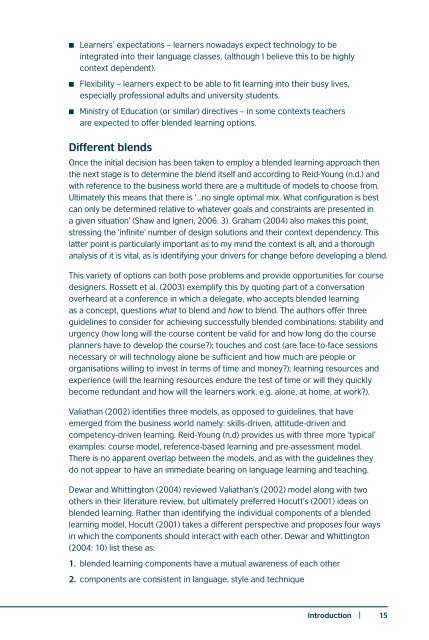Blended Learning in English Language Teaching: Course Design and Implementation
Blended Learning in English Language Teaching: Course Design and Implementation
Blended Learning in English Language Teaching: Course Design and Implementation
You also want an ePaper? Increase the reach of your titles
YUMPU automatically turns print PDFs into web optimized ePapers that Google loves.
■■ Learners’ expectations – learners nowadays expect technology to be<br />
<strong>in</strong>tegrated <strong>in</strong>to their language classes, (although I believe this to be highly<br />
context dependent).<br />
■■ Flexibility – learners expect to be able to fit learn<strong>in</strong>g <strong>in</strong>to their busy lives,<br />
especially professional adults <strong>and</strong> university students.<br />
■■ M<strong>in</strong>istry of Education (or similar) directives – <strong>in</strong> some contexts teachers<br />
are expected to offer blended learn<strong>in</strong>g options.<br />
Different blends<br />
Once the <strong>in</strong>itial decision has been taken to employ a blended learn<strong>in</strong>g approach then<br />
the next stage is to determ<strong>in</strong>e the blend itself <strong>and</strong> accord<strong>in</strong>g to Reid-Young (n.d.) <strong>and</strong><br />
with reference to the bus<strong>in</strong>ess world there are a multitude of models to choose from.<br />
Ultimately this means that there is ‘…no s<strong>in</strong>gle optimal mix. What configuration is best<br />
can only be determ<strong>in</strong>ed relative to whatever goals <strong>and</strong> constra<strong>in</strong>ts are presented <strong>in</strong><br />
a given situation’ (Shaw <strong>and</strong> Igneri, 2006: 3). Graham (2004) also makes this po<strong>in</strong>t,<br />
stress<strong>in</strong>g the ‘<strong>in</strong>f<strong>in</strong>ite’ number of design solutions <strong>and</strong> their context dependency. This<br />
latter po<strong>in</strong>t is particularly important as to my m<strong>in</strong>d the context is all, <strong>and</strong> a thorough<br />
analysis of it is vital, as is identify<strong>in</strong>g your drivers for change before develop<strong>in</strong>g a blend.<br />
This variety of options can both pose problems <strong>and</strong> provide opportunities for course<br />
designers. Rossett et al. (2003) exemplify this by quot<strong>in</strong>g part of a conversation<br />
overheard at a conference <strong>in</strong> which a delegate, who accepts blended learn<strong>in</strong>g<br />
as a concept, questions what to blend <strong>and</strong> how to blend. The authors offer three<br />
guidel<strong>in</strong>es to consider for achiev<strong>in</strong>g successfully blended comb<strong>in</strong>ations: stability <strong>and</strong><br />
urgency (how long will the course content be valid for <strong>and</strong> how long do the course<br />
planners have to develop the course?); touches <strong>and</strong> cost (are face-to-face sessions<br />
necessary or will technology alone be sufficient <strong>and</strong> how much are people or<br />
organisations will<strong>in</strong>g to <strong>in</strong>vest <strong>in</strong> terms of time <strong>and</strong> money?); learn<strong>in</strong>g resources <strong>and</strong><br />
experience (will the learn<strong>in</strong>g resources endure the test of time or will they quickly<br />
become redundant <strong>and</strong> how will the learners work, e.g. alone, at home, at work?).<br />
Valiathan (2002) identifies three models, as opposed to guidel<strong>in</strong>es, that have<br />
emerged from the bus<strong>in</strong>ess world namely: skills-driven, attitude-driven <strong>and</strong><br />
competency-driven learn<strong>in</strong>g. Reid-Young (n.d) provides us with three more ‘typical’<br />
examples: course model, reference-based learn<strong>in</strong>g <strong>and</strong> pre-assessment model.<br />
There is no apparent overlap between the models, <strong>and</strong> as with the guidel<strong>in</strong>es they<br />
do not appear to have an immediate bear<strong>in</strong>g on language learn<strong>in</strong>g <strong>and</strong> teach<strong>in</strong>g.<br />
Dewar <strong>and</strong> Whitt<strong>in</strong>gton (2004) reviewed Valiathan’s (2002) model along with two<br />
others <strong>in</strong> their literature review, but ultimately preferred Hocutt’s (2001) ideas on<br />
blended learn<strong>in</strong>g. Rather than identify<strong>in</strong>g the <strong>in</strong>dividual components of a blended<br />
learn<strong>in</strong>g model, Hocutt (2001) takes a different perspective <strong>and</strong> proposes four ways<br />
<strong>in</strong> which the components should <strong>in</strong>teract with each other. Dewar <strong>and</strong> Whitt<strong>in</strong>gton<br />
(2004: 10) list these as:<br />
1. blended learn<strong>in</strong>g components have a mutual awareness of each other<br />
2. components are consistent <strong>in</strong> language, style <strong>and</strong> technique<br />
Introduction | 15


